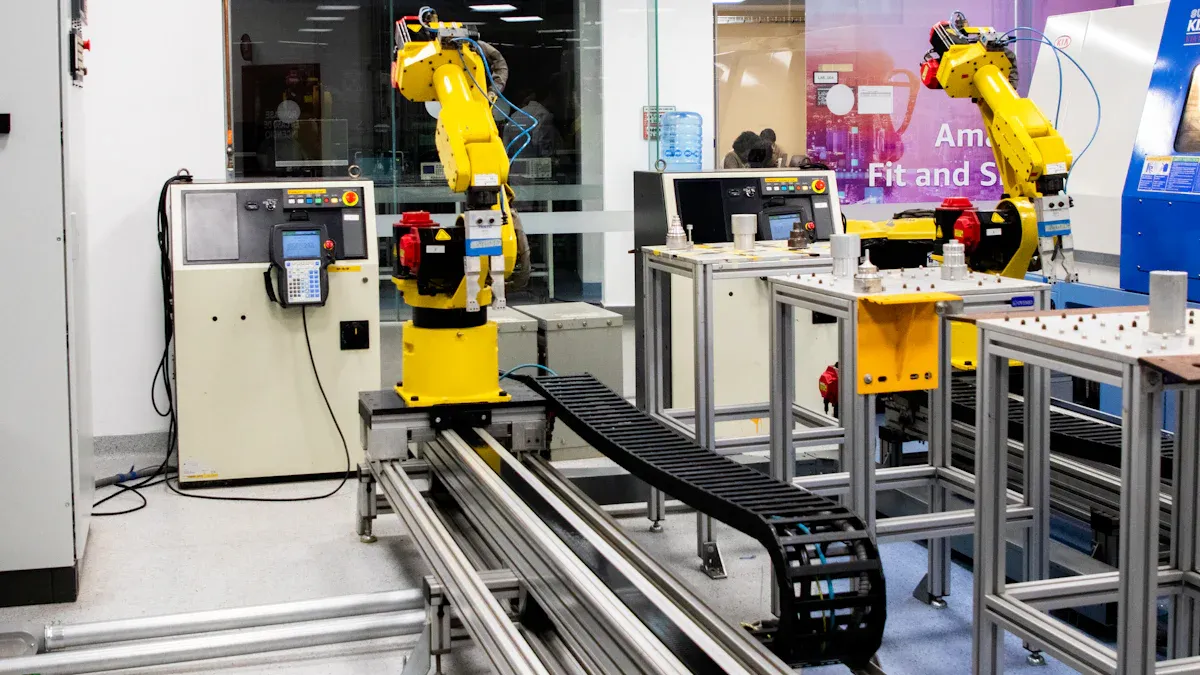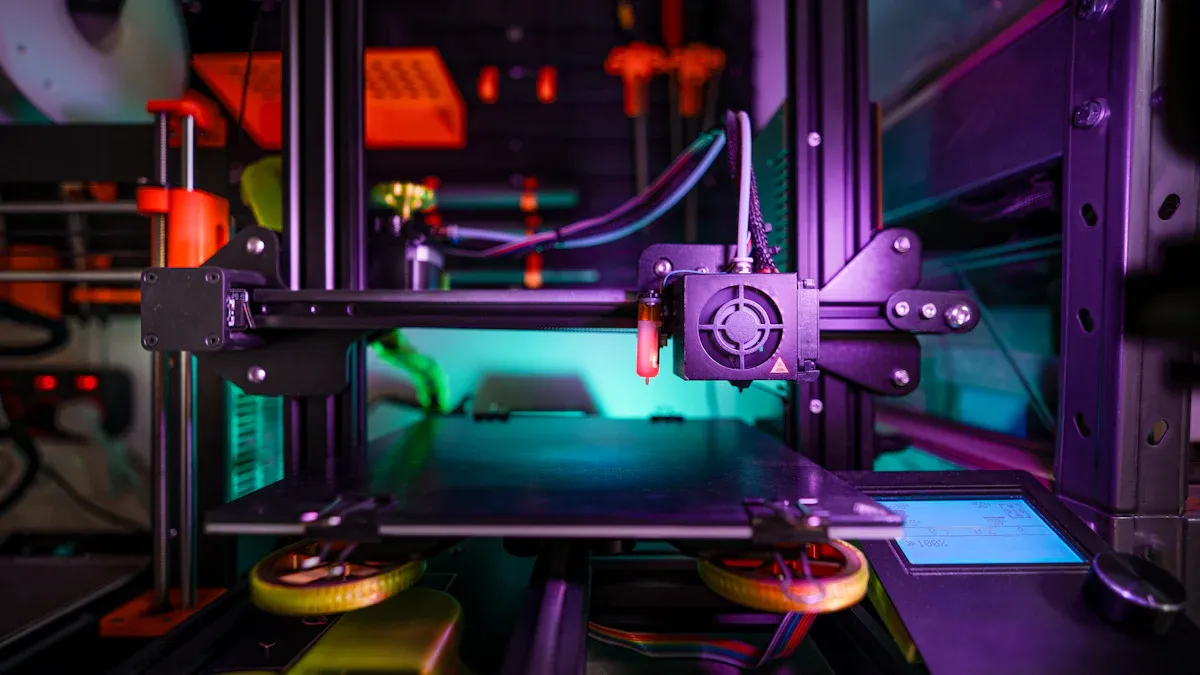Al-Powered Productivity in U.S. Manufacturing Supply Chain

AI is revolutionizing the U.S. manufacturing supply chain by driving Al-Powered Productivity through enhanced efficiency and innovation. In 2024, 35% of manufacturers leveraged AI for predictive maintenance and quality control, while 41% utilized it to manage supply chain data. These advancements in Al-Powered Productivity have significantly improved operations, with AI-driven systems increasing defect detection accuracy by up to 90% and boosting production throughput by 20%.
By minimizing waste and inefficiencies, AI optimizes processes and reduces disruptions. For instance, AI-powered systems in automotive plants predict equipment failures, cutting down on unplanned downtime. Similarly, Coca-Cola’s warehouses employ AI to streamline trailer movements, enhancing storage efficiency. This seamless integration of Al-Powered Productivity is creating smarter, more resilient supply chains across various industries.
Key Takeaways
AI makes factories work better by predicting machine problems. This increases machine working time by 20%.
Smart AI planning helps use inventory wisely. It cuts waste and costs, reducing wait times by 30-50%.
AI demand guessing helps keep the right amount of stock. This stops having too much or too little.
AI finds the best delivery routes. This saves up to 15% on transport and makes deliveries more reliable.
Training workers to use AI improves work and gets them ready for new technology.
AI-Powered Productivity in Inventory Management

Demand Forecasting for Smarter Stock Control
AI-powered demand forecasting transforms inventory management by enabling manufacturers to predict future stock needs with remarkable accuracy. Advanced algorithms analyze historical sales data, market trends, and seasonal patterns to generate precise demand predictions. This capability helps businesses avoid overstocking or understocking, ensuring optimal inventory levels.
For example, AI systems process real-time data from multiple sources, allowing manufacturers to adjust forecasts instantly when market conditions change. This adaptability reduces costs by minimizing excess inventory and preventing stock shortages. A study revealed that AI-driven demand forecasting models improve accuracy significantly, leading to better stock control and cost savings.
Benefit | Description |
|---|---|
Improved Accuracy | AI uses advanced algorithms to analyze data, leading to precise demand predictions. |
Real-time Data Processing | AI can process live data from various sources, allowing for immediate adjustments to forecasts. |
Cost Reduction | Enhanced forecasting precision minimizes excess stock and shortages, reducing overall costs. |
By leveraging AI-powered demand forecasting, manufacturers achieve greater supply chain visibility and operational efficiency, contributing to smarter inventory management.
Dynamic Inventory Planning to Minimize Waste
Dynamic inventory planning, powered by AI, helps manufacturers reduce waste and improve resource utilization. AI systems analyze inventory trends and usage patterns to optimize stock levels and streamline operations. These systems also scale with business needs, efficiently managing increased workloads during peak seasons.
AI-based strategies have demonstrated measurable outcomes in minimizing waste. For instance, firms using dynamic inventory planning report a 30–50% reduction in lead times. Additionally, they achieve significant cost savings by lowering inventory holding expenses and reducing obsolescence. Enhanced customer satisfaction is another benefit, as faster delivery and reliable product availability improve retention rates.
Outcome | Description |
|---|---|
Reduced Lead Times | 30–50% reduction in lead times observed by firms |
Cost Savings | Significant reductions in inventory holding and obsolescence expenses |
Enhanced Customer Satisfaction | Higher customer retention rates due to faster delivery and reliable product availability |
Dynamic inventory planning ensures that manufacturers maintain lean operations while meeting customer demands effectively.
Predictive Maintenance for Operational Efficiency
Predictive maintenance, a key component of AI-powered productivity, enhances operational efficiency by preventing equipment failures before they occur. AI systems analyze historical performance data to forecast potential machine breakdowns, enabling timely maintenance. This approach minimizes unplanned downtime and extends equipment lifespan.
In the automotive industry, predictive maintenance has increased machine uptime by 20%. Similarly, processed food manufacturers have improved overall equipment effectiveness (OEE) by 25% and reduced maintenance costs by 30%. These improvements highlight the transformative impact of AI on manufacturing operations.
Industry Example | Performance Metric | Improvement Percentage |
|---|---|---|
Automotive Manufacturer | Machine Uptime | 20% |
Processed Food Manufacturer | Overall Equipment Effectiveness (OEE) | 25% |
Processed Food Manufacturer | Maintenance Costs | 30% |
By integrating predictive maintenance into their operations, manufacturers achieve higher productivity and lower operational costs, reinforcing the value of AI-powered productivity in the supply chain.
AI-Powered Productivity in Logistics

Route Optimization for Cost-Effective Deliveries
AI-powered route optimization transforms logistics by identifying the most efficient delivery paths. Advanced algorithms analyze factors such as traffic patterns, weather conditions, and fuel consumption to determine optimal routes. This reduces delivery times and minimizes transportation costs.
For example, logistics companies use AI to reroute vehicles dynamically during peak traffic hours. This ensures timely deliveries while reducing fuel expenses. A study revealed that businesses implementing AI-based route optimization achieved up to a 15% reduction in transportation costs. Additionally, these systems improve customer satisfaction by ensuring on-time deliveries.
Key benefits of AI-powered route optimization include:
Cost Savings: Reduced fuel consumption and shorter delivery times lower operational expenses.
Environmental Impact: Optimized routes decrease carbon emissions, contributing to sustainability efforts.
Improved Reliability: Real-time adjustments ensure consistent and dependable delivery schedules.
By leveraging AI-powered productivity in logistics, companies enhance efficiency and reduce costs, creating a competitive advantage in the supply chain.
Predictive Analytics for Supply Chain Resilience
Predictive analytics strengthens supply chain resilience by enabling proactive decision-making. AI systems analyze historical and real-time data to forecast potential disruptions, such as supplier delays or demand fluctuations. This allows businesses to address issues before they escalate.
For instance, predictive analytics enhances demand forecasting, improving inventory management and reducing stockouts. It also identifies risks early, helping companies mitigate potential losses. The financial benefits of AI in logistics are significant, with cost savings ranging from $41,254 to $4,099,617.
Benefit | Description |
|---|---|
Demand Forecasting | Predictive analytics enhances the ability to forecast demand accurately, aiding in inventory management. |
Risk Management | AI helps in identifying and managing risks proactively, leading to cost savings. |
Decision-Making Improvement | Provides reliable guidance for proactive decision-making based on extensive data analysis. |
Predictive analytics not only improves supply chain visibility but also ensures operational continuity. This reinforces the importance of AI-powered productivity in building resilient logistics networks.
Autonomous Vehicles and Smart Warehousing
Autonomous vehicles and smart warehousing represent the future of logistics. Self-driving trucks equipped with AI navigate roads safely and efficiently, reducing the need for human drivers. These vehicles operate 24/7, increasing delivery speed and lowering labor costs.
In warehouses, AI-powered robots streamline operations by automating tasks such as picking, packing, and sorting. For example, Amazon’s fulfillment centers use robotic systems to handle inventory, improving accuracy and efficiency. Smart warehousing also integrates IoT devices to monitor stock levels in real time, ensuring seamless inventory management.
Advantages of autonomous vehicles and smart warehousing include:
Increased Efficiency: Automation reduces manual errors and accelerates processes.
Cost Reduction: Lower labor costs and optimized resource utilization save money.
Scalability: AI systems adapt to changing demands, supporting business growth.
By adopting these technologies, companies achieve higher productivity and operational excellence, further demonstrating the transformative power of AI-powered productivity in logistics.
Human-AI Collaboration for Enhanced Productivity
Leveraging AI Insights for Better Decision-Making
AI systems empower manufacturers to make informed decisions by providing actionable insights derived from vast datasets. These systems analyze historical trends, real-time data, and predictive models to guide strategic planning. For instance, AI enhances predictive maintenance by reducing equipment breakdowns by 70% and lowering maintenance costs by 25%. It also optimizes supply chains by generating accurate demand forecasts and improving quality control through advanced computer vision systems.
By integrating human expertise with AI insights, manufacturers can address complex challenges more effectively. While AI excels at processing data and identifying patterns, human decision-makers bring contextual understanding and creativity to the table. This collaboration ensures that decisions are not only data-driven but also aligned with organizational goals.
Automating Repetitive Tasks to Save Time
AI-powered automation streamlines repetitive tasks, allowing workers to focus on higher-value activities. Tasks such as data entry, inventory tracking, and quality checks can be automated, reducing downtime and enhancing operational efficiency. Studies show that automating these processes leads to faster production cycles with consistent quality.
Organizations that adopt AI automation report significant productivity gains. By reallocating resources from mundane tasks to strategic initiatives, they achieve better outcomes. For example, AI reduces errors in manufacturing processes, contributing to cost savings and improved product reliability. This shift not only saves time but also fosters innovation by enabling employees to engage in creative problem-solving.
Upskilling Workers for AI Integration
The successful integration of AI in manufacturing depends on a skilled workforce. Companies are investing heavily in training programs to equip employees with the necessary skills. For example, 75% of manufacturing firms prioritize simulation skills, while 37% focus on improving information management. Mid-sized companies increased their per-employee training spend from $581 to $902 between 2020 and 2021.
Statistic/Trend | Value/Percentage |
|---|---|
Manufacturing firms prioritizing simulation skills | 75% |
Firms looking to improve information management | 37% |
Upskilling initiatives ensure that workers can collaborate effectively with AI systems. Employees trained in AI tools and technologies can maximize the benefits of automation and data-driven insights. This approach not only enhances productivity but also prepares the workforce for future advancements in AI-powered productivity.
AI continues to act as a transformative force in the U.S. manufacturing supply chain, driving productivity and fostering innovation. A 2024 industry report highlights that over half of surveyed companies already use AI to enhance database management, creating new job roles like database administrators with projected growth rates of 8.2% by 2033.
Blending AI capabilities with human expertise ensures long-term success. For example, Amazon’s AI-driven supply chain optimizes stock levels and logistics, reducing costs and delivery times. With 44% of executives reporting cost reductions through AI, manufacturers must embrace this technology to stay competitive and future-ready.
FAQ
What industries benefit the most from AI-powered productivity in the supply chain?
AI-powered productivity benefits industries like automotive, food processing, and e-commerce. These sectors use AI for predictive maintenance, inventory management, and logistics optimization. For example, automotive manufacturers reduce downtime, while e-commerce companies improve delivery efficiency with AI-driven route planning.
How does AI improve supply chain resilience?
AI enhances resilience by predicting disruptions and enabling proactive responses. Predictive analytics identifies risks like supplier delays or demand fluctuations. Businesses use this data to adjust operations, ensuring continuity and minimizing losses.
Is AI replacing human workers in manufacturing?
AI automates repetitive tasks but does not replace human workers entirely. Instead, it complements human expertise by handling data analysis and routine processes. Companies invest in upskilling employees to work alongside AI, fostering collaboration and innovation.
What are the cost benefits of AI in logistics?
AI reduces costs by optimizing routes, minimizing fuel consumption, and automating warehouse operations. Businesses report up to a 15% reduction in transportation expenses and significant savings in labor costs through smart warehousing and autonomous vehicles.
How can manufacturers start integrating AI into their supply chains?
Manufacturers can begin by identifying areas where AI can add value, such as inventory management or logistics. Partnering with AI solution providers and training employees ensures a smooth transition. Starting small and scaling gradually helps businesses adapt effectively.
💡 Tip: Begin with pilot projects to test AI solutions before full-scale implementation.
See Also
Enhancing Strategies to Tackle Supply Chain Challenges in Tech
Maximizing Opportunities Within Your Automotive Supply Chain
Boosting Productivity Through Innovative AI Supply Chain Solutions
Transforming Future Logistics With AI Supply Chain Technology
Investigating Robotics Innovations for a Supply Chain Transformation
